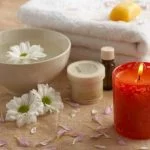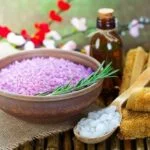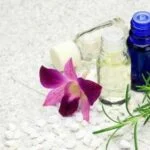Are you interested in learning how to use Himalayan salt for aromatherapy? Himalayan salt has gained popularity in recent years for its potential health benefits, and one of the ways it can be used is through aromatherapy. Aromatherapy is the practice of using natural oils and extracts from plants to promote physical and psychological well-being. When combined with Himalayan salt, it can enhance the therapeutic effects of both practices.
Himalayan salt is believed to be the purest form of salt available and contains minerals such as calcium, potassium, magnesium, and iron. These minerals are known for their potential health benefits including stress reduction, relaxation, improved sleep quality, and air purification. When used for aromatherapy, Himalayan salt can help to create a calming and rejuvenating atmosphere while promoting overall wellness.
In this article, we will explore the origins and properties of Himalayan salt and how it differs from other salts. We will also discuss the different forms of Himalayan salt available for aromatherapy, such as salt lamps, bath salts, and inhalers.
Additionally, we will provide step-by-step instructions on how to set up a Himalayan salt aromatherapy session at home and explore different methods of using Himalayan salt for aromatherapy. Stay tuned to discover the remarkable benefits of incorporating Himalayan salt into your aromatherapy practices.
Understanding Himalayan Salt
Himalayan salt is a type of rock salt that is mined from the Punjab region of Pakistan, near the foothills of the Himalayas. It is known for its distinct pink color, which is due to the presence of trace minerals such as magnesium, potassium, and calcium.
This salt is also believed to be millions of years old and free from the pollutants and toxins that are often found in sea salts. These unique properties make Himalayan salt a popular choice for aromatherapy, as it can provide additional therapeutic benefits beyond just its pleasant aroma.
One of the key differences between Himalayan salt and other salts lies in its mineral composition. While table salt and sea salt are primarily made up of sodium chloride, Himalayan salt contains a wider variety of minerals that can have health benefits when inhaled or absorbed through the skin during aromatherapy sessions. These minerals are thought to help promote relaxation, improve respiratory function, and support overall well-being.
In addition to its mineral content, Himalayan salt is also believed to produce negative ions when heated or exposed to water. Negative ions are thought to have a positive effect on mood and overall mental state, which can further enhance the stress-relieving properties of Himalayan salt aromatherapy.
The use of Himalayan salt for this purpose has become increasingly popular in recent years, with many people incorporating it into their self-care routines as a natural way to reduce stress and promote relaxation.
| Origin | Properties |
|---|---|
| Mined from the Punjab region of Pakistan | Contains trace minerals such as magnesium, potassium, and calcium |
| Believed to be millions of years old | Free from pollutants and toxins often found in sea salts |
| Produces negative ions when heated or exposed to water | Thought to have a positive effect on mood and mental state |
Choosing the Right Himalayan Salt for Aromatherapy
When it comes to incorporating Himalayan salt into aromatherapy, there are several different forms of the salt that can be used. Each form offers unique benefits and can be utilized in various ways to enhance the aromatherapy experience. Here are some popular forms of Himalayan salt that are commonly used for aromatherapy:
- Salt Lamps: Himalayan salt lamps are not only visually appealing, but they also release negative ions into the air when heated by a light bulb. This can help purify the air and create a soothing atmosphere for aromatherapy sessions.
- Bath Salts: Himalayan salt can be ground down into a fine powder and added to bathwater for a relaxing and detoxifying experience. The salt helps to cleanse and exfoliate the skin, making it an excellent addition to any aromatherapy bath routine.
- Inhalers: Himalayan salt inhalers provide a convenient way to inhale the therapeutic properties of the salt. They are often filled with coarse Himalayan salt crystals and used to promote respiratory health and clear nasal passages during aromatherapy sessions.
It’s important to consider your personal preferences and intended use when choosing the right form of Himalayan salt for aromatherapy. Whether you prefer the visual ambiance of a salt lamp, the detoxifying effects of bath salts, or the convenience of a salt inhaler, there is a suitable option for everyone.
In addition to these popular forms, Himalayan salt can also be found in other products such as massage stones, essential oil diffusers, and scrubs. With so many options available, it’s easy to find the perfect way to incorporate Himalayan salt into your aromatherapy routine. Discovering how to use Himalayan salt for aromatherapy can truly enhance your overall well-being and relaxation experience.
Preparing for Aromatherapy
Before starting an aromatherapy session using Himalayan salt, it is essential to gather all the necessary materials. These may include a Himalayan salt lamp, Himalayan salt bath salts, and a Himalayan salt inhaler. The type of aromatherapy session you wish to have will determine which materials are needed.
For example, if you are planning a calming evening bath, you will need Himalayan salt bath salts; if you prefer to purify the air in your living space, a Himalayan salt lamp or an inhaler might be preferable. Once you have gathered your materials, find a quiet and comfortable space where you can relax and unwind.
Next, it’s important to create the right ambiance for your aromatherapy session. Turn off any harsh lighting and opt for soft or natural light instead. Consider playing soothing music or nature sounds to enhance the relaxing atmosphere. You may also want to dim the lights to create a more calming environment.
Once your space is ready, it’s time to use the Himalayan salt for aromatherapy. If using a Himalayan salt lamp or inhaler, simply follow the manufacturer’s instructions for optimal use and placement in the room.
If preparing a Himalayan salt bath, add the desired amount of bath salts to warm running water and allow them to dissolve before entering the tub. It’s important to stay hydrated during and after an aromatherapy session, so be sure to have water nearby.
By following these step-by-step instructions, individuals can learn how to use Himalayan salt for aromatherapy at home with ease.
| Material | Instructions |
|---|---|
| Himalayan Salt Lamp/Bath Salts/Inhaler | Follow manufacturer’s instructions |
| Ambiance | Soft lighting; soothing music; calming scents |
| Himalayan Salt Bath Preparation | Add desired amount of bath salts to warm running water |
| Stay Hydrated | Have water nearby during and after the session |
Aromatherapy Techniques With Himalayan Salt
When it comes to incorporating Himalayan salt into your aromatherapy routine, there are several different methods you can explore. Each method offers unique benefits and allows you to customize your experience based on your specific needs and preferences.
1. Inhalation:
Inhaling the aroma of Himalayan salt is a popular method for aromatherapy. You can place Himalayan salt crystals in a bowl and add a few drops of your favorite essential oil. Allow the aroma to fill the air as the salt naturally absorbs and diffuses the scent. Alternatively, Himalayan salt inhalers are also available, providing a convenient way to breathe in the therapeutic properties of both the salt and essential oils.
2. Topical Application:
Another way to use Himalayan salt for aromatherapy is through topical application. You can create your own Himalayan salt scrub by mixing finely ground Himalayan salt with carrier oils and essential oils to create an exfoliating scrub that also provides aromatherapy benefits. This method not only helps relax your senses but also rejuvenates and nourishes your skin.
3. Salt Baths:
Using Himalayan salt in bath salts is a great way to combine the therapeutic benefits of aromatherapy with the relaxation of a warm bath. Adding a scoop of Himalayan bath salts infused with essential oils creates a soothing and aromatic experience that can help alleviate stress, promote better sleep, and soothe sore muscles.
Exploring these different methods will allow you to fully appreciate how to use Himalayan salt for aromatherapy while tailoring your experience to best suit your individual wellness needs.
Benefits of Himalayan Salt Aromatherapy
When it comes to aromatherapy, Himalayan salt offers a wide range of physical and mental health benefits that can enhance your overall well-being. Incorporating Himalayan salt into your aromatherapy practices can help promote relaxation, reduce stress, improve sleep quality, and even alleviate certain respiratory conditions. Here’s a closer look at the specific benefits of using Himalayan salt for aromatherapy.
Relaxation and Stress Reduction
One of the key benefits of Himalayan salt in aromatherapy is its ability to promote relaxation and reduce stress. When used in a salt lamp or through inhalation, the negative ions released by Himalayan salt can help create a calming atmosphere and improve mood. The gentle glow of a salt lamp can also contribute to a soothing ambiance that promotes relaxation after a long day.
Improving Sleep Quality
Himalayan salt can also be beneficial for improving sleep quality when used in aromatherapy. The calming effects of the negative ions released by the salt can help create an environment conducive to restful sleep. Additionally, using Himalayan salt bath salts before bedtime may help relax the body and mind, leading to a more peaceful night’s rest.
Respiratory Health Benefits
Incorporating Himalayan salt into your aromatherapy practices can also support respiratory health. Inhaling the microscopic particles of Himalayan salt has been known to clear nasal passages, reduce mucus buildup, and alleviate symptoms of allergies and asthma. This makes Himalayan salt inhalers an effective option for individuals looking to improve their respiratory wellness through natural means.
These are just some of the many benefits you can experience by incorporating Himalayan salt into your aromatherapy routine. From promoting relaxation and reducing stress to improving sleep quality and supporting respiratory health, Himalayan salt offers a holistic approach to enhancing both physical and mental well-being through aromatherapy practices.
Safety Precautions
When it comes to using Himalayan salt for aromatherapy, it is important to consider certain safety precautions to ensure a positive and effective experience. While Himalayan salt offers numerous benefits for aromatherapy, there are potential risks and considerations that users should be aware of. By understanding these safety precautions, individuals can make the most of their Himalayan salt aromatherapy sessions without any adverse effects.
Quality and Purity of Himalayan Salt
One of the key safety precautions when using Himalayan salt for aromatherapy is to ensure that the salt used is of high quality and purity. It is essential to source Himalayan salt from reputable suppliers who guarantee its authenticity and lack of contaminants. Purchasing low-quality or adulterated Himalayan salt may pose health risks and diminish the therapeutic benefits of aromatherapy.
Allergic Reactions and Sensitivities
Another important consideration is the potential for allergic reactions or sensitivities to Himalayan salt. While this is rare, individuals with known allergies or sensitivities to certain minerals present in Himalayan salt should exercise caution when using it for aromatherapy. It is advisable to perform a patch test before full use, especially when applying Himalayan salt topically or using it in direct contact with the skin.
Inhalation Safety
When using Himalayan salt for inhalation as part of aromatherapy, it is crucial to practice proper inhalation techniques and avoid overexposure. Inhaling excessive amounts of salt particles may irritate the respiratory system, particularly in individuals with pre-existing respiratory conditions such as asthma or chronic obstructive pulmonary disease (COPD). To mitigate this risk, individuals should follow recommended usage guidelines and consult a healthcare professional if they have any concerns about inhalation safety.
By being mindful of these safety precautions and taking necessary measures to address them, individuals can enjoy the therapeutic benefits of using Himalayan salt for aromatherapy while minimizing potential risks. With a focus on quality, individual sensitivities, and safe inhalation practices, incorporating Himalayan salt into aromatherapy routines can contribute to overall well-being and relaxation.
Conclusion
In conclusion, Himalayan salt is a versatile and beneficial addition to any aromatherapy routine. Whether used in the form of a salt lamp for ambient diffusion, as bath salts for relaxation, or in an inhaler for therapeutic benefits, Himalayan salt offers a natural and effective way to enhance your aromatherapy practices. By understanding its origins and properties, as well as the different forms available for use, individuals can make informed choices when incorporating Himalayan salt into their wellness routines.
The benefits of using Himalayan salt for aromatherapy are plentiful. From its ability to cleanse the air and promote relaxation to its potential to alleviate respiratory issues and improve overall well-being, Himalayan salt has been cherished for its therapeutic properties for centuries. The incorporation of Himalayan salt into aromatherapy techniques allows individuals to experience these benefits in a holistic manner, addressing both physical and mental health concerns through natural means.
As you explore how to use Himalayan salt for aromatherapy, it is important to remember safety precautions and be mindful of any potential risks associated with its use. By following the proper guidelines and instructions for setting up an aromatherapy session at home, individuals can reap the rewards of Himalayan salt without compromising their well-being.
Ultimately, I encourage you to consider integrating Himalayan salt into your own aromatherapy routines and discover firsthand the transformative effects it can have on your overall wellness.
Frequently Asked Questions
How Do You Use Himalayan Salt With Essential Oils?
Himalayan salt can be used with essential oils in a few different ways. One popular method is to mix the salt with a few drops of essential oil and place it in a bowl or jar where the scent can naturally diffuse into the air.
Another way is to create a Himalayan salt inhaler by adding essential oils to the inhaler and taking deep breaths.
How Do You Make a Himalayan Salt Diffuser?
Making a Himalayan salt diffuser is relatively simple. Start by filling a small glass jar with Himalayan salt, and then add your favorite essential oils to the salt. Place the lid on the jar and let it sit for 24 hours before removing the lid to enjoy the soothing scent from the diffuser.
Can I Put Pink Salt in My Diffuser?
It is not recommended to put pink salt in your diffuser for aromatherapy purposes. While Himalayan salt diffusers are popular, they typically use either dry or wet methods of dispersing scents, rather than placing actual salt crystals into the diffuser itself.
Using pink salt in this way may cause damage to the diffuser and may not provide the desired aromatic effect.

Are you looking for a natural way to improve your health and wellbeing?
If so, aromatherapy may be the answer for you.





